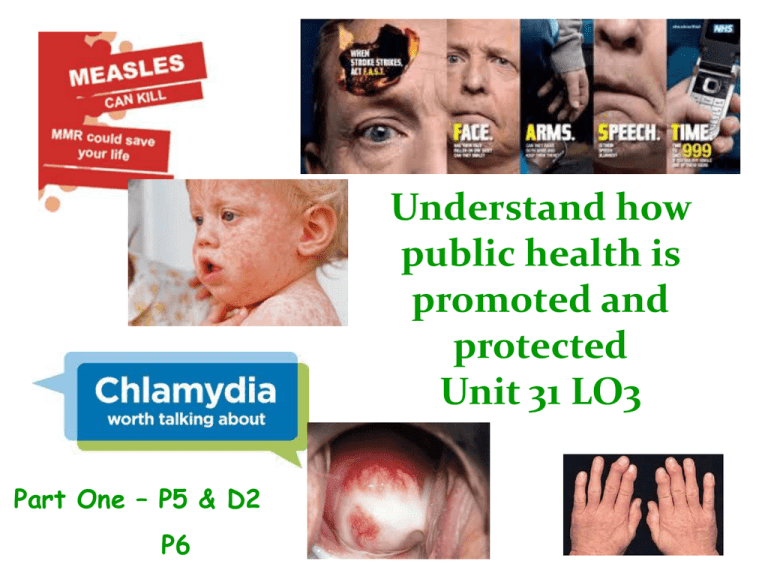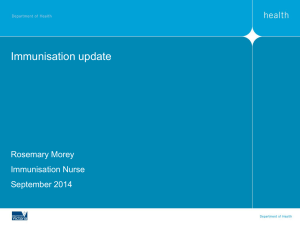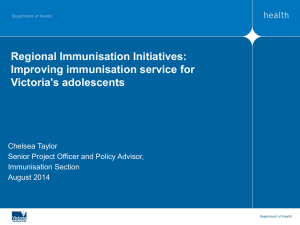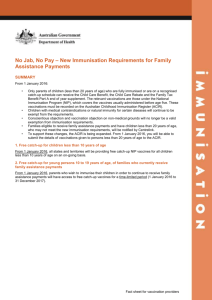
Understand how
public health is
promoted and
protected
Unit 31 LO3
Part One – P5 & D2
P6
Understand how public health is promoted
and protected
Learning
Outcome - The
learner will:
Assessment Criteria
Pass The learner can:
Understand
how public
health is
promoted
and
protected
P5
Explain the role of
health promotion in
improving public health
P6
Explain how public
health is protected
P7
Describe methods
used to prevent or
control a named
communicable and a
named non
communicable disease
Merit – in
addition to the
pass criteria
the learner
can:
Distinction –
in addition to
the pass and
merit criteria
the learner can
D2
Evaluate how a
health
promotion
campaign has
impacted on
UK public
health
Understand how public health is promoted
and protected
Learning
Outcome - The
learner will:
Assessment Criteria
Pass The learner can:
Understand
how public
health is
promoted
and
protected
P5
Explain the role of
health promotion in
improving public health
P6
Explain how public
health is protected
Merit – in
addition to the
pass criteria
the learner
can:
Distinction –
in addition to
the pass and
merit criteria
the learner can
D2
Evaluate how a
health
promotion
campaign has
impacted on
UK public
health
Slides are colour coded to help you!
Follow the suggestions in pink for your assignment
P7 is on part 2 slide show
Role of Health Promotion…
•
•
•
•
Reasons for health education
campaigns:
Improving health and well being
– give up to date information eg
how many units of alcohol are
recommended for adult women.
Encouraging the use of
preventative methods – using a
condom to prevent against
disease
Increasing skills to enable
people to take control of their
lives – help people choose – eg
Say no to smoking by being
supported in a group
To aid understanding of
environmental causes of ill
health- a baby’s chest infection
is caused by the poor housing
conditions – this could empower
the mother to take action.
•
•
•
•
Target Audiences
People at risk of disease – eg
women over 50 should have
mammogram
People at risk from early
death – eg man who’s dad died
of heart attack before aged 50
which could be hereditary
People at risk from their life
styles – eg smokers – key factor
in heart and lung diseases,
unsafe sex, no exercise
People at risk from their
environment – eg hygiene poor,
too many people in one room,
cooking facilities limited, damp
housing, homeless, pollution etc
Explain the role of health promotion in
improving public health
Practical strategies:
Topics to cover:
• Enabling people to
exert control
• Practical strategies to
address challenges
faced by society
• Ottawa Charter
• United Nation report
on Human
Development
•Providing health clinics
in areas of
social/health inequality
•Provide diet/exercise
examples (C4L)
•Advice and guidance on
cessation of smoking,
drinking alcohol and
sexually transmitted
diseases (Sex worth
talking about, Drink
Aware etc)
Helping people gain control…
Individual can then:
State will:
• Promote health
• Provide services
• Persuade people to
change
• Provide choice
• Provide resources/money
• Improve conditions
• Encourage research
• Listen to views/opinions
•
•
•
•
•
•
Make own health better
Act on advice and guidance
Think about life style choices
Use NHS sensibly
Act on changing priorities
Use personal responsibility
to prevent disease where
possible
Ottawa Charter
This was an international
conference on Health
Promotion in November
1986 – they
produced the Charter to
achieve Health for All by
the year 2000 and beyond.
Health promotiondefinition used in
Ottawa Charter 1986
• Process of enabling people
to increase control over and
to improve their health
• PIES
• Identify and realise
aspirations
• Satisfy needs
• Change and cope with the
environment
• More about well being than
healthy lifestyles
Health promotion
Prerequisites for health:
• Peace
• Shelter
• Education
• Food
• income
• Stable eco system
• Sustainable resources
• Social justice and equality
• Advocate
• Enable
• Mediate
Health promotion action
means
Create supportive
environments
Strengthen community
actions
Develop personal skills
Reorient health
services
Moving into the future
Each of the participants in the
conference pledged to these points
United Nations report on Human
Development
• Each year the UN produces reports in human
development – and links the HDI to various
health and economic data
• They have a different emphasis each year
• The latest data ranks UK 26th in health
• The data table will tell you the mortality rates
due to things such as cardiac/ malaria etc so you
can compare countries.
• It shows a steady increase spending on public
health wrt GPD – 6.8% 2005 to 8.1% in 2010
• life expectancy in 2012 was 80.3 years in UK
Fast Facts & Results | UNDP
UN report on
Human
Development
Topics for UN
reports
Health
Education
Income
% loss due to inequality
Lowering of inequality in health and education, rising in income
P5
• Write a short explanation of health
promotion
• Using each of the points to cover explain
how these help to improve public health:
• Enabling people to exert control
• Practical strategies to address challenges faced by society
• Ottawa Charter
• United Nation report on Human Development
• Don’t forget to use examples, graphs etc
to illustrate your work.
Evaluate how a health promotion campaign has
impacted on UK public health (D2)
•
•
Choose a National campaign
Good campaigns are Chlamydia, Change 4 Life, Skin cancer, National No
Smoking Day – choose one you already know something about!
•
•
•
•
Think about the impact= positive and negative
Will need to use statistics, tables and graphs to help you explain the impact
Consider ethics – is the campaign good for all?
Think about impacts e.g. cost and accessibility as well as the actual health
change.
Does everyone benefit from the campaign – why?
The campaign may look at allocation of resources and strategies but doesn’t
look at evaluating patient services and outcomes- is this helpful?
Does the promotion look at underlying factors (inequality, housing, work life
balance, accessibility fo services, morbidity, disability and quality of
services) and how does this effect impact?
How does the campaign measure impact? Is this current? Is it unbiased?
Is there a difference between individual impact vs group or population
impact? Which is your campaign designed to impact?
Have changes to services or care been a result of evaluation of the
campaign?
Hase evaluation of the campaign lead to “feeder” campaigns?
•
•
•
•
•
•
•
Explain how public health is
protected (P6)
Specific strategies
• Immunisation
• Disease surveillance
• Health and genetic
screening programmes
Environmental protection
from hazards
• Waste
disposal/treatment
• Supply of safe water
• pollution control
• control of food
preparation storage and
sale
• climate change
Immunisation and Vaccination
• HPV
immunisation
• Tuberculosis
• MMR/measles
• Small pox
• Chicken Pox
• Shingles
• Seasonal flu
• Brief definition of
immunisation and vaccination
• Find out the recommended
programme for vaccinations –
by age
• Look for graphs that show
you the incident rate of the
diseases against vaccination
rates – choose three
examples
• Explain how the immunisation
programme helps to protect
public health – and what
happens when people choose
not to have the vaccinations
You must show graphs
and explain the impact
before and after
immunisation.
http://www.thinkhard.org/2007/09/mmr-vaccine-tru.html
Measles can
cause death;
in 2006 an
uninoculated
thirteen-yearold (with an
underlying
lung condition)
was the first
child to die of
measles in the
UK for 14
years
The effects of the controversy were to undermine confidence and to drastically
reduce the uptake of the MMR vaccination. Between 1995, when information
began to appear suggesting that the MMR vaccine was implicated in bowel
disorders, and 1998, when the paper was published alleging the link with
autism, the uptake of the vaccine fell from 92% (close to the World Health
Organisation's recommended level of 95% for the protection of a population) to
88%. It hovered at about this level until 2001 when the case was taken up by
the media with a sustained attack on the vaccine.
By 2003, the level of uptake had fallen to around 80%. By then, 12% per year of
young children had been put at risk by a scare which proved to be
unsubstantiated. And it took until 2005 to bring the uptake rate back to 84%,
which is better but still more than 10% below the World Health Organisation's
recommended level.
• Disease surveillance
• Health and genetic
screening programmes
Disease surveillance
Looks at who gets ill, why
people get ill and planning
for the future
Some communicable diseases are
notifiable (eg Rubella, Mumps,
Measles, TB)
30 diseases are monitored - Then
data can be collated.
So outbreaks can be responded to
and trends found.
Reports are published every week
week 51
•International diseases are also
tracked – eg Avian Flu
Screening is designed to make an
early diagnosis of certain
Diseases – WHO has 5 criteria that
have to be met before a screening
programme can be set up.
• Find out about two common health
screening tests (e.g. pap smear,
breast cancer, Chlamydia, bowel
cancer) and how people find out
about them.
• How they have influenced health?
Genetic screening is designed to
detect conditions linked to genes –
some are associated with pre-natal
screening such as Downs
Syndrome and Cystic Fibrosis
• Find out about two common
genetic screening tests
• What are the ethical considerations
of genetic screenings?
• What about screening for cancer?
•Produce a table of the 30 diseases – briefly discuss why you think they
have been chosen
•Using named examples explain how disease surveillance protects health
Disease surveillance – week 51 2013 – summary authority
annual report until 2010
•
•
•
•
•
Environmental protection
from hazards
Waste disposal/treatment
Supply of safe water
pollution control
control of food preparation storage and sale
climate change
Choose TWO to
explain how
environmental
protection from
hazards helps
protect health
http://www.hpa.org.uk - latest environmental health project
• https://www.gov.uk/government/uploads/sy
stem/uploads/attachment_data/file/153698
/Environmental_Statistics_key_facts_2012
.pdf











